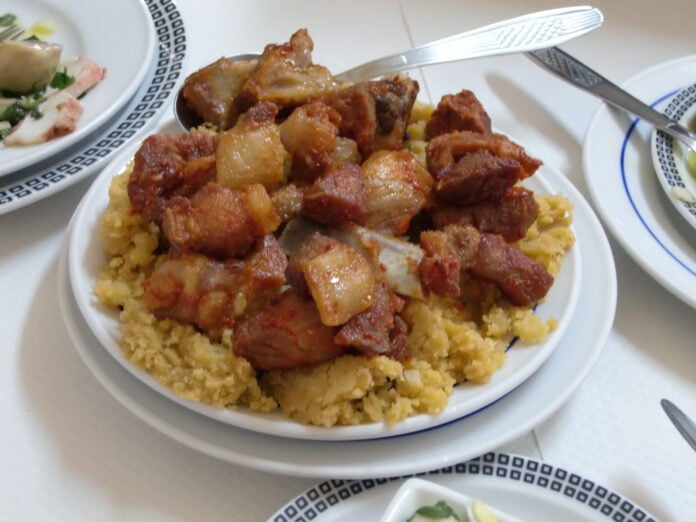When was the last time you went to a restaurant and ordered old bread? What if I told you the Alentejo region has a magic recipe that turns old bread into the best thing ever? Don’t believe me? Try it yourself and be dazzled by Alentejo’s migas.
MI-WHAT?
Migas is a dish well-known for its simplicity, flavor, and connection to the local cuisine. Based on a philosophy of sustainability and the use of cheap, everyday ingredients, and originally made in a fire pot made of glazed red clay, migas stands out for the way it combines bread and good quality olive oil, resulting in a comforting meal full of authentic flavors.
ITS ORIGINS
For centuries, migas has been a hallmark of Alentejo’s cuisine, especially in winter. It’s a high-calorie dish that was born as a way of making use of the hard bread that fed the men who worked in the fields in the countryside. The main ingredient in the recipe is Alentejo bread. Of ancestral origin, made in the traditional way, unmistakable in taste, shape, and texture, it is the basis of many of the region’s typical recipes and an icon of the region’s identity.
HOW TO EAT IT
You can have it both as a side dish or as a main dish, depending on what you choose to include in your recipe. For example, migas with coffee and milk is a breakfast bomb that will have you full until nighttime, and migas with asparagus or cauliflower make for a great lunch on their own.
But typically, migas goes with pork. It’s a perfect combination because the migas absorb all the oils and fats, which in turn refines its flavor. And there’s no tastier pork than that from the black pigs that live in the Alentejo, so we will use that today. Which part? Up to you. Secretos, entrecosto, lombinhos, and plumas are some of the best meats you’ll ever taste, so the choice is all yours. For this recipe, we will go with the easier-to-find lombinhos, or tenderloins.
PORTIONS
4 to 6.
INGREDIENTS
- 500g of black pork tenderloin
- 1 chorizo sausage
- 1kg of homemade wheat bread (hard)
- 3 cloves of garlic
- Olive oil
- Salt
INSTRUCTIONS
- Cut the meat into regular cubes. Crush the garlic and coat the meat with it, leaving it there for a few hours (or even overnight).
- Cut the chorizo into small pieces.
- Fry the meat and chorizo in a frying pan, adding a just splash of water (so they don’t burn). Don’t add olive oil yet, we need the meat fat’s taste. Remove the meat as it browns.
- Now pass the fat from frying the meat through a sieve and keep it nearby.
- Cut the bread into slices and pour it into the frying pan. Sprinkle with a little boiling water and immediately beat it with a wooden spoon, crushing it.
- Once most of the water is absorbed by the bread, season it with some of the fat you kept all while whisking the migas, but don’t use it all up. They should be well seasoned but not soaked in fat.
- Shake the pan over the heat and roll the migas into a thick omelet shape. This is not obligatory, but it’s how this dish is traditionally presented.
- Once the migas are wrapped in a thin golden crust, place them on the platter, grease with some of the fat you have left and a splash of olive oil, and garnish with the meat.
- Rejoice, as you just found a way to turn old bread into a tasty meal!
Now that you know how to cook it, you can try it with different ingredients (just don’t change the old bread, that one’s essential). Any meal consisting of meat goes well with migas.
And you know what else goes well with migas, especially if you’re eating it with pork? A glass of red wine. The Alentejo is well-known nationally for its wines, but still relatively unknown in the foreign market, so make sure you try them.
Bom apetite!


